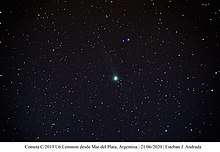C/2019 U6 (LEMMON)
C/2019 U6 (Lemmon), or Comet Lemmon is a long period comet with a near-parabolic orbit discovered by the Mount Lemmon Survey on October 31, 2019.[2] It made its closest approach to the Sun on June 18, 2020. It is currently visible near the naked eye limit at an apparent magnitude of 6.0. It's the 2nd brightest naked eye comet of 2020 after comet C/2020 F8 (SWAN).[3] It will remain visible near the naked eye limit in June.[4]
 C/2019 U6 observed with an amateur telescope in June 2020 | |
| Orbital characteristics A | |
|---|---|
| Observation arc | 1.54 yr |
| Aphelion | 960 AU (inbound) 604 AU (outbound) |
| Perihelion | 0.91427 AU |
| Earth MOID | 0.0288 AU (4.31 million km; 11.2 LD) |
| Last perihelion | 18 June 2020 |
| Barycentric period | ~10,500 yr (inbound)[1] ~5,200 yr (outbound) |
This perihelion passage will decrease the comets orbital period from about 10500 years to about 5200 years.[1]
Even though C/2019 U6 has an Earth-MOID of 0.0288 AU (4.31 million km; 11.2 LD),[2] the closest approach to Earth will be June 29, 2020 at a distance of 0.82 AU (123 million km; 320 LD).
References
- JPL Horizons barycentric solution for epoch 1950 (before entering planetary region)
Goto JPL Horizons
Ephemeris Type: Orbital Elements
Center: @0 (Solar System Barycenter)
Time Span: 1950-01-01 to 2050-01-01 and Step Size: 100 years
1950-Jan-01 is "PR= 3.84E+06 / 365.25 days" = 10513 years - "JPL Small-Body Database Browser: C/2019 U6 (Lemmon)". ssd.jpl.nasa.gov. Retrieved 11 April 2020.
- Ghosh, Trinankur. "Comet Observation database (COBS)". Retrieved 10 May 2020. "C/2019 U6 plot"
- Seiichi Yoshida. "C/2019 U6 ( Lemmon )". Retrieved 10 May 2020.
This article is issued from Wikipedia. The text is licensed under Creative Commons - Attribution - Sharealike. Additional terms may apply for the media files.


_on_1_May_from_Indonesia.jpg)